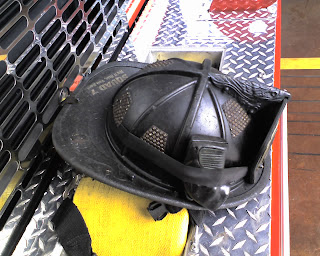I'm in a writing mood tonight. Since I don't seem to get much email, but plenty of google hits are returning my blog, I'm thinking about occasionally pulling interesting search criteria and answering those to the best of my ability.
Here goes.
"How do they do CPR in an ambulance?"
The smart-aleck in me wants to answer with just "very carefully", but I'll try to elaborate. The biggest help we can have while doing CPR is having a driver that is actually mindful that while they need to get to the ER fast, they have to slow down to an extent. The folks in the back are standing, and won't appreciate any sudden turns or braking. Every ambulance I've seen or worked in, has a metal bar mounted to the ceiling. Common slang for it is the O.S. Bar (use your colorful imagination).
My experience with adult CPR has been standing with legs spread wide for better balance, one hand firmly gripping the OS bar, the other on the patient's chest for compressions. Sometimes, I've been known to slide open the nearest cabinet door and grab the sill instead for better balance.
For a pediatric patient, I'll sit on the stretcher with the baby.
Some ambulances have what we call center-mount stretchers, meaning it's not against a wall, and has a CPR seat. I've yet to try using a CPR seat, but I'm just not quite sure how to wrap my brain around effective compressions when I'm sitting down and having to reach over to the patient.
What's fun (to me at least), is being the one to "surf the stretcher" at the ER. Basically, you stand on the lower part of the stretcher's frame and do compressions while you and the patient are wheeled into the ER. Lowering the stretcher from it's highest level (which they all seem to be at by default when unloading), will help considerably in making compressions easier.
~~~~~~~~~~~~~~~~~~~~~~~~~~~~~~~~~~~~~~~~~~~~~~~~~~~~~~
"Comparisons of private cars to ER and ambulances to ER"
Let me preface this by saying that I do not have exact figures, nor do I advocate taking off in your own car instead of calling 911 for that heart attack, or using 911 to "be seen faster" for your stumped toe.
I'm going to address this one by taking what seems to me as the most unbiased opinion I can give. Keep in mind though, this is MY opinion. If you've been here a while, you've surely noticed I'm biased, opinionated, and I give my version of what happened. The following has plenty of truth to it, but is NOT to be taken as the be-all, end-all answer.
Every single person that walks, hops, limps, crawls, or is rolled into a hospital is triaged. That means the sickest person gets seen first. Period.
The nurses don't care if you've been there 3 hours or 3 days, the acute MI (heart attack) will be seen long before the sprained ankle.
I've had plenty of people that wanted to be transported by emergency ambulance so they would be seen quicker. Imagine their disappointment when we rolled them past the ER and out to triage, lowered the stretcher, and helped them sign in for their 5 day-old, non-medicated headache.
911, is supposed to be for emergencies. If you have an emergency, I'll be more than happy to do everything I can to help you and get you to an ER. However, I am not a taxi service, that's why we have a public transportation system. You can pay them less than $2, or pay me over $500 and possibly cost someone having a real emergency their life.
Obligatory Furlough Post
1 month ago

No comments:
Post a Comment